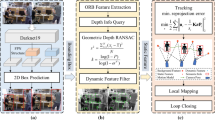Abstract
Using the global positioning system (GPS) for people tracking continues to get easier. A person can transmit his/her GPS location from the carried mobile devices. The location is usually displayed as a dot on a digital map. However, a dot on the map is insufficient to reveal the person’s actual situation, e.g., an accident being happening. If the GPS is incorporated with an IP (Internet Protocol) camera, the camera image is critical in revealing the person’s actual situation and to improve the above-mentioned insufficient information. We present an approach to facilitate such incorporation. The approach consists of three phases: locating, tracking and monitoring collision. When the GPS coordinates of a person are within the field-of-view (FOV) of a camera, the approach enters the locating phase. The GPS coordinates are transformed to specify a candidate area (CA) in the image. The update of GPS coordinates is used to filter those moving objects within the CA until only one remains. After the person is located, he is being tracked using the shortest Euclidean distance method to find the most likely object in the next image. If the person collides with other objects while being tracked, a template matching technique, the sum of absolute difference (SAD), is used to locate the person in the collision area. The tracking is done after the person leaves the FOV of the camera. In the experimental studies, the tracking of one to three persons was performed using the implemented prototype. The average locating error of the tracking phase is only 5 pixels. The highest and average tracking success rates are 95.9% and 90.6%, respectively. These results show that the proposed approach is accurate and feasible for people tracking by incorporating GPS and IP cameras.












Similar content being viewed by others
References
Babu RV, Pérez P, Bouthemy P (2007) Robust tracking with motion estimation ad local kernel-based color modeling. Image Vision Comput 25(8):1205–1216
Cucchiara R, Grana C, Piccardi M, Prati A (2003) Detecting moving objects, ghosts, and shadows in video streams. IEEE Trans Pattern Anal Mach Intell 25(10):1337–1342
Haritaoglu I, Harwood D, Davis LS (2000) W4: real-time surveillance of people and their activities. IEEE Trans Pattern Anal Mach Intell 22(8):809–830
Hu W, Hu M, Zhou X, Tan T, Lou J, Maybank S (2006) Principal axis-based correspondence between multiple cameras for people tracking. IEEE Trans Pattern Anal Mach Intell 28(4):663–671
Javed O, Rasheed Z, Alatas O, Shah M (2003) Knight: a real time surveillance system for multiple overlapping and non-overlapping cameras. In: ICME 2003, pp 649–652
Kim C, Hwang JN (1999) A fast and robust moving object segmentation in video sequences. In: IEEE ICIP 1999, pp 131–134
Kim C, Hwang JN (2002) Fast and automatic video object segmentation and tracking for content-based applications. IEEE Trans Circuits Syst Video Technol 12:122–129
Lenz RK, Tsai RY (1987) Techniques for calibration of the scale factor and image center for high accuracy 3D machine vision metrology. In: IEEE ICRA 1987, pp 68–75
Liao HC, Chu PT (2009) A novel visual tracking approach incorporating global positioning system in a ubiquitous camera environment. Info Tech J 8(4):465–475
Liao HC, Wu HJ (2010) Automatic camera calibration and rectification methods. Meas + Control J 43(8):251–254
Micheloni C, Foresti GL, Snidaro L (2005) A network of co-operative cameras for visual surveillance. IEE Proc Vision Image Signal Process 152(2):205–212
Muñoz-Salinas R, Aguirre E, García-Silvente M (2007) People detection and tracking using stereo vision and color. Image Vision Comput 25(6):995–1007
Richardson IEG (2003) H.264 and MPEG-4 video compression: video coding for next-generation multimedia. Wiley, New York, p 228
Shah M, Javed O, Shafique K (2007) Automated visual surveillance in realistic scenarios. IEEE Multimedia 14(1):30–39
Tsai RY (1987) A versatile camera calibration technique for high-accuracy 3D machine vision metrology using off-the-shelf TV cameras and lenses. IEEE Rob Autom 3(4):323–344
Zhu L, Zhou J, Song J (2008) Tracking multiple objects through occlusion with online sampling and position estimation. Pattern Recognit 41:2447–2460
Acknowledgments
This work was financially supported by the National Science Council under Grant No.: NSC 97-2221-E-324-043.
Author information
Authors and Affiliations
Corresponding author
Rights and permissions
About this article
Cite this article
Liao, HC., Lu, CY. & Shin, J. Incorporation of GPS and IP camera for people tracking. GPS Solut 16, 425–437 (2012). https://doi.org/10.1007/s10291-011-0242-8
Received:
Accepted:
Published:
Issue Date:
DOI: https://doi.org/10.1007/s10291-011-0242-8




